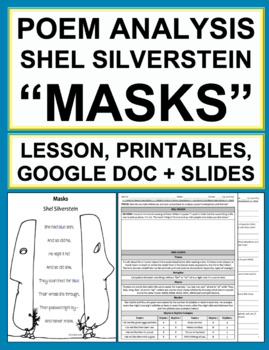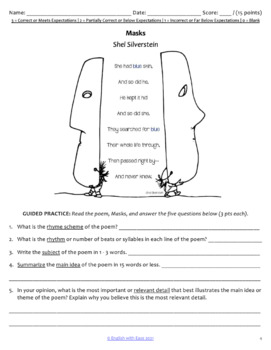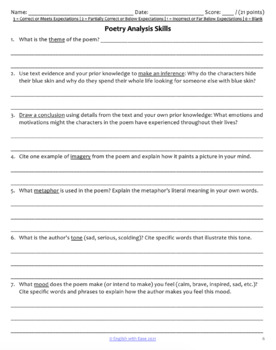Shel Silverstein Masks Poetry Analysis | Self Confidence, Diversity & Inclusion
- Zip
- Google Apps™

What educators are saying
Description
Use Shel Silverstein's Poem, Masks, to practice poetry analysis, rhythm, rhyme, theme, metaphor, inference skills, text connections and EVERY common core reading and writing skill, while also discussing the importance of embracing differences, confidence, self-esteem, diversity and inclusion - NO PREP editable lesson plan, student printables, PowerPoint slides, Google Slides, Google Doc and rubrics (Printable & Digital).
Pick and choose from 7 student handouts and questions to practice relevant reading and writing skills or complete them all over one or more poetry lessons to practice every common core reading and writing skill (inference, sequence, compare contrast, summary, main idea, text connections, characterization, conflict, point of view, author's purpose, tone, mood, imagery, text connections, literary analysis, opinion writing, poetry writing, etc.)
Students close read Shel Silverstein's poem, Masks, summarize the text, interpret metaphors, analyze theme, identify rhyme and rhythm, and using the included mini-lesson, guided practice and independent practice activities.
Zip Includes (Editable Printable & Digital):
- Lesson Plan
- Student Printables
- PowerPoint Slides
- Google Slides
- Google Doc
- Common Core Standards
- Learning Focus Question: How do we make inferences and text connections to analyze a poem’s metaphors and themes?
- Introductory Teacher Script
- Mini Lesson: Theme, Metaphor, Rhyme, Rhythm
- Poem: Masks by Shel Silverstein
- Guided Practice
- Independent Practice
- Exit Slip
- Early Finisher Activity
- Extra reusable "Assessment" handout to use with any poem or fictional text!
- 3-point rubric for effortless grading
SEE PREVIEW
This is a lifelong tool!
Reuse editable mini lesson and pair "Assessment" handout with ANY poem or work of literature for repeated, spiraled practice and assessment of writing and reading literature skills.
Want more poetry analysis?
- The Hill We Climb by Amanda Gorman (2021 Inaugural Poem)
- Music as Poetry: Teach Poetry with Any Lyrics
- Spoken Word Poetry Video Activity
- Poetry Writing Unit
- Poetry Task Cards with Shel Silverstein
Want more no prep analysis, writing and elaboration practice?
YOU MAY ALSO LIKE ;)
Teach Reading Standards with Videos: 18 LESSON FUN BUNDLE
Critical Lens Essay with 40 Inspirational Quotes FUN BUNDLE
Literary Analysis Paragraph with Lyrics, Spoken Word & Film: 36 Prompts + Videos
Controlling Idea Paragraph Synthesis Essay with 80 Inspirational Videos BUNDLE
Bell Ringers: Paraphrase 60 Inspirational Quotes
Complete Roots, Suffixes & Prefixes
SAT Vocabulary Bell Ringers - 180 Daily SAT Words, PPT, 36 Weekly Quizzes & Key
Informational Text Bundle: 50 Articles & 200 Questions
INSPIRATIONAL CULTURALLY RELEVANT PRINT & GO
Social Emotional Learning Bell Ringers for Any Subject
Inspirational Adult Coloring Book
Shel Silverstein Poetry Task Cards
Inspirational Bell Ringers for the Entire Year
Bell Ringers: Paraphrase 60 Inspirational Quotes
Social Media Activities for Any Text
32 Sports & Hip Hop Articles to Engage Apathetic Students
Sports & Video-Game Homework for Reluctant Readers
Sports & Video-Game Writing Prompt Task Cards to Engage Reluctant Learners
Sports & Video-Game Reading Responses for Any Text
Nonfiction Reading Fun Bundle: 6 Engaging Articles & Videos
Comparative Writing Fun Bundle: 6 Lyrics & Videos
Poetry Writing Unit – Mini-Project
Poetry Task Cards with Shel Silverstein
Music as Poetry: Teach Poetry with Any Lyrics
Spoken Word Poetry Video Activity
Illuminati – Author’s Purpose, Argument & Evidence
Interesting Text - Guided Reading Strategies & Annotation Lesson
Inspirational Text Activity - Characterization, Author’s Purpose & Main Idea
Lil Wayne Critique Reading Response Activity
Quote of the Week: Daily Bell Ringers for Entire Year
**BROWSE ALL OF MY PRODUCT CATEGORIES**
Culturally Relevant ELA Lessons
Emotional Intelligence SEL Curriculum
Social Justice & Global Citizenship Curriculum
Holiday Print and Go Lesson Plans
Social Studies Lessons & Units
Differentiation & SpEd Professional Development
Common Core Standards:
CCSS.ELA-LITERACY.CCRA.R.1. Read closely to determine what the text says explicitly and to make logical inferences from it; cite specific textual evidence when writing or speaking to support conclusions drawn from the text. CCSS.ELA-LITERACY.CCRA.R.2. Determine central ideas or themes of a text and analyze their development; summarize the key supporting details and ideas.
CCSS.ELA-LITERACY.CCRA.R.3. Analyze how and why individuals, events, or ideas develop and interact over the course of a text. CCSS.ELA-LITERACY.CCRA.R.4. Interpret words and phrases as they are used in a text, including determining technical, connotative, and figurative meanings, and analyze how specific word choices shape meaning or tone. CCSS.ELA-LITERACY.CCRA.R.5. Analyze the structure of texts, including how specific sentences, paragraphs, and larger portions of the text (e.g., a section, chapter, scene, or stanza) relate to each other and the whole. CCSS.ELA-LITERACY.CCRA.R.6. Assess how point of view or purpose shapes the content and style of a text. Integration of Knowledge and Ideas: CCSS.ELA-LITERACY.CCRA.R.7. Integrate and evaluate content presented in diverse media and formats, including visually and quantitatively, as well as in words. CCSS.ELA-LITERACY.CCRA.R.8. Delineate and evaluate the argument and specific claims in a text, including the validity of the reasoning as well as the relevance and sufficiency of the evidence. CCSS.ELA-LITERACY.CCRA.R.9. Analyze how two or more texts address similar themes or topics in order to build knowledge or to compare the approaches the authors take. CCSS.ELA-LITERACY.CCRA.W.1. Write arguments to support claims in an analysis of substantive topics or texts using valid reasoning and relevant and sufficient evidence. CCSS.ELA-LITERACY.CCRA.W.2. Write informative/explanatory texts to examine and convey complex ideas and information clearly and accurately through the effective selection, organization, and analysis of content. CCSS.ELA-LITERACY.CCRA.W.4. Produce clear and coherent writing in which the development, organization, and style are appropriate to task, purpose, and audience.
CCSS.ELA-LITERACY.CCRA.W.9. Draw evidence from literary or informational texts to support analysis, reflection, and research.
Why wait? Use Shel Silverstein's Poem, Masks, to practice poetry analysis, rhythm, rhyme, theme, metaphor, inference skills, text connections and EVERY common core reading and writing skill, while also discussing the importance of embracing differences, confidence, self-esteem, diversity and inclusion- NO PREP editable lesson plan, student printables, PowerPoint slides, Google Slides, Google Doc and rubrics (Printable & Digital).





